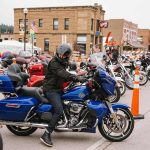
Volunteer Spirit in Law Enforcement: A Reflection on Cpl. Norm Smith’s Journey
In today’s fast-changing world, public service and community engagement continue to shape the local landscape. One striking example is the transformative path of RCMP Cpl. Norm Smith, who, after years of escorting and supporting the Tour de Rock, boldly decided to switch from the rumble of his Harley to the quiet intensity of bicycle riding. His journey is not only a testament to personal evolution but also a reflection on how volunteer roles in law enforcement can expand beyond traditional boundaries.
Cpl. Smith’s decision to participate in the Tour de Rock ride represents more than an athletic challenge—it is a symbolic embrace of change, a willingness to tackle the tricky parts and tangled issues of reinventing one’s self. As he transitions from a seasoned motorcycle escort to a novice cyclist, his story provides valuable insight into the ways that law enforcement officers can adapt to new roles while still serving their communities in critical ways.
From a Harley to a Bicycle: Breaking Down Barriers in Public Service
The switch from a heavy, roaring motorcycle to a seemingly delicate bicycle might appear, at first glance, as an obvious downgrade. However, Cpl. Smith’s journey is anything but straightforward. Known among colleagues as the “big guy on escort duty” who could expertly maneuver an 800-pound Harley, Smith was accustomed to controlling complex machinery on high-speed highways. His new challenge—mastering the art of bicycle riding—demands not only physical adaptation but also a reconfiguration of mental focus.
This transition underlines the importance of flexibility and continuous learning in law enforcement roles. Just as legal professionals must learn to make their way through tangled statutory twists and turns, Cpl. Smith is learning to ride a bike with the same dedication he brings to his police work. In doing so, he manages to illuminate a broader truth: sometimes, providing support to one’s community means stepping out of one’s comfort zone and tackling new responsibilities, no matter how intimidating they may seem.
Overcoming the Confusing Bits: Learning Bicycle Riding as an Experienced Officer
For a man who spent decades mastering the art of motorcycle riding, the decision to learn a completely different mode of travel is filled with both excitement and nerve-racking challenges. Despite having only a fleeting memory of riding a bicycle during childhood—the memory even marred by a scar from an accident—Smith embraced the task head-on. The story of his earliest brush with bicycle riding, however rudimentary, reveals how even well-seasoned professionals might sometimes need to dig into the fine points of new skills.
Learning something new, especially as an adult, can be akin to facing a maze of tricky parts and tangled issues. Every twist and turn of the bicycle’s steering, braking, and gear shifting process can seem overwhelming at first. It is, in many ways, comparable to grappling with a complicated piece of legislation or sorting out the confusing bits of a multifaceted criminal investigation. Yet, Cpl. Smith’s determination to succeed—even when the prospect of going downhill at 60 kilometers an hour seemed downright scary—reveals the power of persistence, practice, and a supportive community.
Preparation, Physical Transformation, and the Nitty-Gritty of New Athletic Pursuits
One of the most critical aspects of Smith’s transformation involves not only learning how to ride a bicycle but also preparing physically for the rigorous demands of long-distance cycling. Recognizing his need to build stamina, Smith embarked on a disciplined training program that included eight weeks of intense practice rides. He also initiated a weight loss program, shedding 25 pounds in the process—a change that has positively impacted his overall health, improving his sleep quality and reducing his snoring.
This journey of physical transformation is a potent reminder that any significant change involves attention to both the mind and body. In the spirit of public service, Smith’s proactive approach to self-improvement underscores how law enforcement professionals can lead by example. The key takeaway here is that significant achievements often require tackling the little details together—be it through consistent training, dietary adjustments, or simply taking the time to learn the subtle parts of a new skill.
Enhancing Public Safety: The Role of Volunteer Support in Community Events
Beyond the personal benefits, Smith’s participation in the Tour de Rock has a broader impact on community safety. For years, he has been a pillar of support, coordinating vehicles, clearing paths, and ensuring that riders have a safe journey through busy highways. His new endeavor, riding a bicycle, requires a similar level of dedication and vigilance, particularly during high-speed training sessions on winding, steep hills.
From a legal perspective, volunteer roles in community events have significant implications for public safety and the maintenance of order in society. Law enforcement officers who engage in such activities bring valuable insights about risk management and proactive planning. These experiences may even help shape future policies that address how public safety agencies can better serve during large-scale events, demonstrating that support roles are both essential and transformative.
- Ensuring rider safety on narrow, winding roads
- Coordinating emergency response measures during high-speed events
- Fostering a culture of community involvement among law enforcement
- Supporting local fundraisers and charity events that promote public health
It is important to note that such volunteer activities are not without risk. The potential for life-threatening accidents on steep hill descents or in packed groups of cyclists requires robust training programs and a clear strategy for emergency response. The public must appreciate that every safety measure, no matter how small, plays a critical role in preventing dangers before they escalate into full-blown crises.
Challenges of Learning New Athletic Skills Later in Life
For many, the thought of picking up a new athletic discipline later in life is off-putting. The idea of mastering a new set of physical demands while contending with the fine details of bicycle mechanics can be intimidating. Yet, learning to cycle is also a metaphor for personal growth in the face of age-old habits and ingrained routines. Cpl. Smith’s experience highlights how personal evolution is, in many ways, about getting into the nitty-gritty of new challenges and embracing continuous learning.
There are several attitudes that contribute to successfully navigating the small distinctions between familiar modes of transportation and those that are entirely new:
- Embracing Humility: Admitting that there is always room for growth, regardless of experience, is essential.
- Maintaining Patience: The learning curve can be steep and full of twists and turns, but steady practice leads to improvement.
- Cultivating Support Networks: Peer encouragement and shared experiences can significantly boost morale during training periods.
- Setting Incremental Goals: Breaking down the learning process into manageable steps can help overcome what initially appears to be overwhelming.
This attitude can be applied not only to athletic endeavors but also to the many complicated pieces of law enforcement training and civic duty. As a long-serving RCMP officer, Smith’s willingness to take on new challenges serves as an inspiring model for professionals across disciplines. It suggests that change, however scary, is part and parcel of personal and professional development.
Public Perception and Peer Perspectives on Changing Roles in Law Enforcement
The reaction of peers and the general public to Cpl. Smith’s decision to learn bicycle riding has been multifaceted. On one hand, many admire his courage; on the other, some are skeptical about the practicality of a veteran officer taking on a completely new physical challenge. However, the broader narrative is clear: public service is about more than tradition—it is about adaptation and the continuous pursuit of self-improvement.
In communities where law enforcement officers are highly visible, their actions often serve as benchmarks for civic behavior. Leaders like Cpl. Smith provide examples of how professional roles need not remain static. They demonstrate that finding your way through the confusing bits of change is a universally applicable lesson for individuals from all walks of life. Public confidence is bolstered when officers are seen stepping up to personal challenges that mirror the difficulties faced by many citizens.
Some of the legal implications of such a transition involve reassessing the roles of police officers as public figures and community helpers. Volunteer service in events like the Tour de Rock is evidence that the boundaries of law enforcement extend beyond the traditional confines of duty. Such service blurs the lines between official capacity and personal commitment to community wellbeing, challenging both the perception and practice of public safety.
Practical Safety Considerations and Risk Management on Two Wheels
Riding a bicycle at high speeds in dense traffic environments exposes cyclists to unique risks that differ markedly from those associated with motorcycles. The limitations of a bicycle—especially regarding braking and sharp cornering—make even short descents potentially risky. Smith’s experience on narrow, twisting roads underlines the need for robust practical safety measures.
Several safety tips emerge for veteran officers transitioning into roles that require new athletic skills:
- Wear Appropriate Safety Gear: Helmets, padded clothing, and even reflective accessories are must-haves.
- Follow a Structured Training Program: Gradually increasing distance and speed is a way to build confidence without overwhelming your body.
- Understand Your Route: Familiarizing yourself with local terrain, especially steep or narrow roads, can help in anticipating potential hazards.
- Maintain Regular Equipment Checks: Ensuring that your bicycle is in top condition minimizes technical risks.
These points echo the legal principle that effective risk management is built on attention to detail. Whether in drafting safety protocols for public events or ensuring officers are well-prepared for unexpected challenges, the combination of careful preparation and adaptive thinking proves indispensable.
Community Engagement and Its Ripple Effects on Public Policy
The ripple effects of Cpl. Smith’s volunteer efforts extend well beyond his personal journey; they reach into the broader arenas of public policy and community engagement. His commitment to a cause like the Tour de Rock helps spotlight the value of public service and the importance of investing in community-based events.
A few key areas where such involvement might influence wider policy discussions include:
| Issue | Community Impact | Potential Policy Response |
|---|---|---|
| Volunteer Support Funding | Encourages civic pride and cross-agency collaboration | Increased grants or subsidies for community events |
| Officer Training Programs | Enhances skills beyond traditional law enforcement | Incorporation of physical endurance and risk management modules |
| Safety Protocol Development | Improves responses during emergencies at public events | Creation of collaborative frameworks between public agencies and event organizers |
By contributing in these areas, officers like Cpl. Smith not only serve on the ground but also play a key role in shaping new approaches to public safety and civic engagement. In many ways, these volunteers act as living case studies, highlighting how proactive community participation can lead to the development of policies that address the complicated pieces of urban life.
The Role of Resilience and Determination in Law Enforcement Careers
Cpl. Smith’s story is filled with moments that highlight the resilience required to operate in a role that is, by its very nature, demanding. His journey underscores the notion that the path to personal growth is often dotted with both setbacks and victories. It is this relentless determination that ultimately allows him—and by extension, many law enforcement professionals—to steer through career shifts that might otherwise appear overwhelming.
In reflecting on his personal journey, several critical themes stand out:
- Adaptability in the Face of Change: Recognizing that even long-held roles can evolve is essential for modern police work.
- Commitment to Continuous Learning: Whether it is mastering a new athletic skill or understanding new community needs, learning never stops.
- The Value of Persistence: Success often comes from consistent effort over time, regardless of initial obstacles.
- Leading by Example: When officers take on personal challenges, they inspire community members to embrace change in their own lives.
These themes are not only reflective of the personal growth journey but also provide a roadmap for other professionals who may be contemplating stepping outside their comfort zone. Just as the legal world is full of confusing bits and subtle challenges, the world of law enforcement is evolving, and stories like Smith’s encourage a culture of openness and reinvention.
Bridging the Gap Between Professional Duty and Personal Challenge
One of the most fascinating aspects of Cpl. Smith’s experience is how personal challenges can reinforce professional duty. By taking on a new physical ordeal, he reinforces the message that public service is as much about personal development as it is about external responsibilities. This duality is critical in understanding how modern law enforcement is not confined to a single method of operation; instead, it thrives on the blend of physical agility, mental sharpness, and the willingness to face the intimidating.
The benefits of developing new skills are manifold:
- Enhanced Physical Condition: Improved stamina, strength, and overall health contribute to better performance on duty.
- Increased Mental Focus: Learning a new skill helps reset the mind, fostering creative problem-solving skills.
- Broadened Skill Set: Acquiring capabilities outside of traditional law enforcement techniques can lead to innovative tactical approaches.
- Community Inspiration: Personal growth stories motivate others to get involved, sparking a cycle of positive change.
By merging his personal challenge with his professional role, Cpl. Smith effectively bridges the gap between self-improvement and public safety, creating a powerful narrative that resonates with both his peers and the wider community.
A Closer Look at Volunteer Support Dynamics in Community Events
Volunteer support in community events, especially those involving public safety and civic participation, is loaded with subtle parts that require careful consideration. The dynamics of organizing, supporting, and ultimately succeeding in these endeavors are as full of problems as any high-stakes legal case. Yet, instead of shying away from these challenges, community volunteers and law enforcement officers are steadily figuring a path toward constructive solutions.
For instance, consider the following aspects that define volunteer support dynamics:
- Coordination and Communication: Ensuring that all team members understand their roles requires clear, consistent communication.
- Risk Assessment and Management: Proactively identifying and mitigating risks helps maintain safety during high-adrenaline events.
- Flexibility in Role Assignment: The willingness to switch roles—from escort to support crew member—demonstrates a robust organizational structure.
- Resource Allocation: Efficient distribution of equipment and manpower is key to handling logistical challenges effectively.
These factors, when managed effectively, enhance the overall success of public events and reflect how volunteer roles can have a far-reaching impact in communities. They also offer a blueprint for legal and administrative planners who aim to integrate more flexible models of participation within conventional law enforcement practices.
Legal Perspectives on Volunteerism and Public Safety Initiatives
From an editorial perspective, the relationship between volunteerism and public safety is an area ripe for discussion. Legal experts often face the nerve-racking task of crafting policies that support voluntary participation while also ensuring that public safety guidelines are adhered to. Cpl. Smith’s journey provides a real-world example of how these two worlds can overlap.
Key legal observations include:
- Liability Concerns: When officers volunteer in roles that differ from their core duties, legal frameworks must be carefully adjusted to cover any potential mishaps.
- Policy Flexibility: Regulations should allow for innovative service models that encourage volunteerism without compromising safety standards.
- Resource Protection: Ensuring that both personal and public resources are safeguarded during voluntary activities is critical for long-term sustainability.
- Transparency and Accountability: Any shifts in duty or role require clear documentation and oversight to maintain public trust.
These considerations are not merely administrative hurdles; they have real consequences for public policy and the structuring of volunteer programs. For the legal community, understanding the little twists involved with volunteer service can help create a more supportive framework for those willing to step up in unconventional ways.
Taking the Wheel: Lessons Learned and Future Implications
As we take a closer look at Cpl. Smith’s remarkable journey, several lessons emerge that have implications well beyond the realm of cycling or law enforcement. His story is a clear example of how individual determination—when combined with a willingness to face intimidating challenges—can lead to new ways of serving the public.
Future implications of such endeavors may include:
- Broadening Officer Training: Incorporating modules that focus on physical agility and alternative transportation methods.
- Enhanced Community Engagement: Developing programs that encourage more active public participation in safety events.
- Revised Safety Protocols: Creating updated guidelines that address the fine details associated with non-traditional volunteer roles.
- Policy Reforms: Adjusting legal frameworks to recognize and support the evolving roles of law enforcement in community events.
In many respects, these future directions highlight the underlying theme of Cpl. Smith’s transition: change is inevitable, and embracing it can lead to improved policies, better training, and, ultimately, a safer community. His path—from the rumble of a Harley to the careful cadence of a bicycle—illustrates the power of personal growth and the importance of facing life’s tricky parts head on.
As society evolves and the demands on public service grow increasingly complex, stories like this remind us that transformation is not only possible but also necessary. The challenges associated with picking up a new skill later in life—no matter how overwhelming at first—can become catalysts for broader, positive change across all areas of community interaction.
Final Thoughts: Embracing Change in an Ever-Evolving Public Service Landscape
In wrapping up this reflection on Cpl. Norm Smith’s journey, it is essential to recognize that every step toward personal reinvention is an opportunity for community enrichment. Whether in the realm of volunteer support at local events or in broader public policy discussions, the determined spirit of individuals like Smith provides a roadmap for continuous improvement.
For many who work in law enforcement or in public service, the notion of taking a new approach—be it learning how to ride a bicycle or engaging in other physically demanding tasks—can seem as intimidating as facing an uphill battle. However, the benefits of confronting these challenges are immense. They serve as reminders that it is never too late to change, learn, and ultimately evolve into an even more capable version of oneself.
As communities continue to demand higher levels of safety and civic participation, public figures like Cpl. Smith illuminate the way forward. They teach us that the path to excellence often requires embracing the fine shades of change, accepting the little details of personal development, and courageously stepping into the unknown. Whether it means shedding old habits, rethinking training approaches, or reconfiguring legal frameworks, the journey of adaptation proves super important in a world where evolution is the only constant.
In the grand tapestry of public service, every new challenge is not a setback but rather a stepping stone toward building a safer, more resilient community. Let Cpl. Norm Smith’s willingness to take the wheel in a new ride encourage not only law enforcement professionals but also every citizen to figure a path through the confusing bits of change. His story reassures us that if a seasoned officer can trade in his heavy motorcycle for a bicycle and master its twists and turns, then all of us can learn to embrace the nerve-racking and sometimes scary aspects of transformation.
Ultimately, the journey from Harley to bicycle is more than a personal triumph; it is a shining example of how public service is ever-evolving. By stepping up to volunteer in new and challenging roles, officers like Smith not only inspire their peers but also help pave the way for innovative safety practices and strengthened community bonds. In doing so, they remind us that revitalizing our approaches to civic duty and public safety is both a personal challenge and a shared responsibility.
As we look to the future, it is clear that stories like these will continue to stimulate discussions among legal experts, community leaders, and public administrators. After all, the ability to steer through life’s complicated pieces and take on new challenges embodies the true spirit of service—one that is essential, dynamic, and ready to meet the demands of an ever-changing world.
Originally Post From https://www.nanaimobulletin.com/news/tour-de-rock-cpl-norm-smith-a-big-guy-on-a-small-bicycle-1028429
Read more about this topic at
Pedaling against odds, cycling for a cause ♂️ Meet Saneed …
Pedaling Against The Odds: Ultra-Cyclist Adil Teli’s Road …


